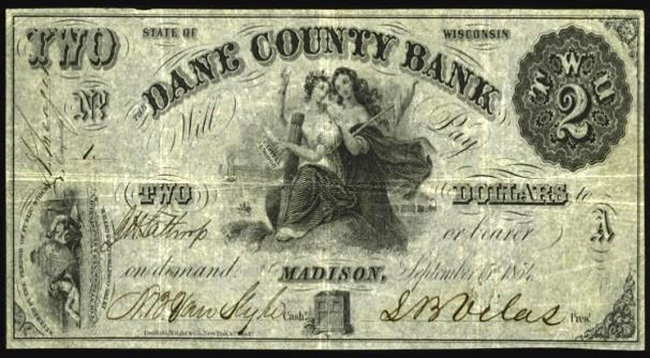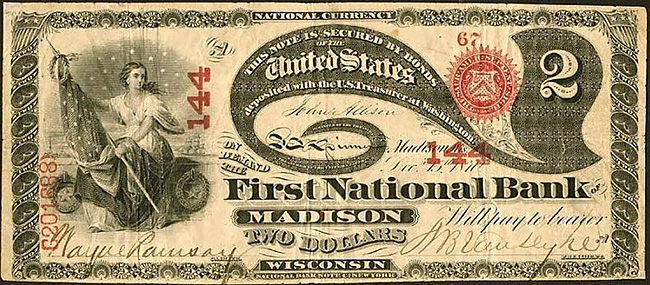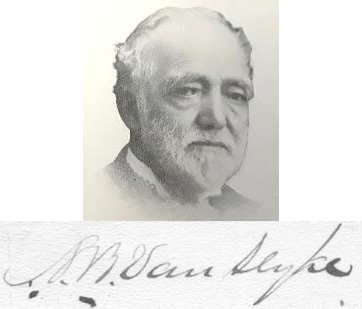
NOW Articles Written By Members
Bullion And Coin Tax Exemption – Act Now!
Is There A Twenty Cent Piece We Can Add To A Collection
Capped Bust Half Dollars: A Numismatic Legacy
U.S. Innovation Dollars: Our Most Under-Collected Coin?
My 2023 ANA Summer Seminar Adventure
In defense of the American Women's Quarters
A look back in numismatic history – the Hicksville Silver Dollar Hoard
The proofs so few of us collect: Jefferson Nickels
A look back in numismatic history – a story too good to be true
Kilroy promotes war bond sales
Just passing through a short-lived bank
The Kewaunee Line Encased Coin Folder
Lyman C. Draper: Collector, Historian, Genealogist
The WWII Philippine Silver Dump
A Sextet Of Scientists From Wisconsin
Wisconsin Territorials: Come Josephine, In My Wayback Machine
New Milwaukee Buck: A Kha$h Middleton Note
Not Your Typical Olympic Sports
Rahr Brewing Of Wisconsin... and beyond
>> More articles in the Archive
For more NOW Articles Written By Members,
What’s in a Name?
[By Matthew A. Janzen #2082]
A person’s name is the first thing we note about someone in print. Names can infer a certain amount of information, either intentional or not. Sally is most likely female while John is probably male. Heinrich, Ahmed or Xiang have foreign or ethnic connotations. Parents also name their children after family members, places or ideas such as John Smith, Jr., Paris or Faith. All of these give us some sense of the person.
Sometimes parents name their children after a famous person. Is this to honor the original bearer of the name or is it wishful thinking their child will share some traits? Without inquiring firsthand, we may never know what inspired Daniel and Laura VanSlyke to name their son Napoleon Bonaparte VanSlyke when he was born in 1822.
Whatever the reason, N.B. VanSlyke had some impressive boots to fill.
N. B. VanSlyke was born to Daniel and Laura VanSlyke in New York. This was just a little over a year-and-a-half since his more famous namesake died. His father Daniel passed when he was just nine. The remainder of his childhood was spent with maternal grandfather John Mears. Being an only child, he grew to count his cousins as siblings and all accounts suggest he experienced a content childhood with an education, too.
VanSlyke eventually married Laura Ann Sheldon in 1844. N.B. and Laura’s marriage was fruitful, producing daughter Laura in 1844, son Charles in 1847 and after moving his family to Madison in 1853, son Elisha in 1855. Unfortunately, Laura passed away only four years after moving to Wisconsin. Two years after his first wife Laura’s death, VanSlyke was married to Ruth Ann Corbett. This led to daughter Maie and son James.
Not much is known about VanSlyke’s early life in New York. He tried his hand at farming from 1844 until about 1850. After this, he entered the business of salt manufacturing at Salina, now part of Syracuse, N.Y. It is assumed he continued with the salt trade until his move to Wisconsin. There is no mention of why VanSlyke decided to move his family over to Wisconsin. It could have been simply for greater opportunity.
Some accounts speak of VanSlyke arriving in Madison with money from others to invest. Which people and how much money is unknown, but it appeared to be lots. The Dane County Bank was organized in spring 1853, no doubt with investor money as backing. VanSlyke acted first as cashier and later became president of the bank. VanSlyke also partnered with James Richardson that year, engaging in the area real estate business.

1st note issued - Dane County Bank, N.B. VanSlyke Cashier
VanSlyke was very active in other affairs of early Madison. Upon receiving city status in 1856, he was appointed to the first Madison city council as alderman. There, VanSlyke was instrumental in shaping the capitol city by helping erect city hall, securing fire equipment, and selecting a site for the sprawling Forest Hill Cemetery. Not everything was without criticism. An 1856 bond financing early development was issued with a face value of $100,000 but only netted $79,000. Further scrutiny came when funds were deposited into the Dane County Bank of which he was still serving as the cashier.
Thankfully, the storm was weathered, and he was cleared of any wrongdoing.
VanSlyke also served as Regent at the newly organized state university (now the University of Wisconsin – Madison). In his nearly 30 years there, one major accomplishment was securing the purchase of 60 individual lots totaling 195 acres. This expanded the campus west of University Hill, north of present-day University Avenue and south of Lake Mendota. The purchase was secured by the issuance of $40,000 of Dane County bonds. There is no doubt that VanSlyke’s banking and real estate connections were of utmost importance during the process of developing the school.
His real estate enterprises included funding construction of several elegant homes in the Mansion Hill Historic District. Although the namesake mansion at 28 East Gilman was built for the VanSlykes, the family never lived there. After the death of his first wife, he decided against it. A more modest, existing home was purchased in 1860 at 510 North Carroll St. where N.B. VanSlyke lived with his second wife for the remainder of his life.
VanSlyke’s financial ventures expanded in 1859 to include lumber interests in the north part of the state and peat as a fuel source. Though soon, his life, like many others, would deal with an unexpected turn of events. Outbreak of the Civil War called on VanSlyke to serve the Union as captain and assistant quartermaster general for all of Wisconsin in 1861. While rising to the rank of lieutenant colonel over the war, he was in charge of procuring all aspects of supplies for Wisconsin soldiers. His hand drawings illustrate plans for barracks at Camp Randall, long before it was ever a host to football games.
The end of the Civil War ushered in the national banking era. It didn’t take long for VanSlyke to see benefits of converting the state-chartered Dane County Bank to a federal charter. He assumed the title of president at the newly organized First National Bank of Madison in 1865 and with the role came the task of signing the facility’s notes.

FNB Madison WI, #144 – First Charter Period, $2
Wayne Ramsay, Cashier – N.B. VanSlyke, President
You would think VanSlyke’s signature would be found on many notes as he held the title of bank president for nearly 45 years, but this is not true. A single example each of the original series $1, $2 and $5 exist, all bearing his signature. No series 1875 are presently known on the bank. A lone $10 and three $20 1882 series brown backs are known, but only one $20 is confirmed to bear his signature. A single known 1902 series red seal $20 likely has it, but it is not confirmed. No series afterwards carries VanSlyke’s signature.
VanSlyke was more than a local personality. As president of the Wisconsin Bankers Association, he represented the state nationally. In September 1885 he gave a speech against the use of silver certificates due to unrestrained mining and mintage of silver coin. He was concerned that they were being devalued against other backed paper.
“The difference between a treasury note and the insidious silver certificate is beginning to be realized … the treasury note promises to pay what we want; the silver certificate, to pay what none care to keep. This difference, if the system is continued, will develop into a currency panic.”

Like many bankers, he was against the “Free Silver” movement and preferred the pro-gold financial establishment. After a long and eventful life, N.B. VanSlyke died from pneumonia at 86, on Feb. 14, 1909, in Madison. He was fittingly laid to rest in Section 2, Lot 044 of the Forest Hill Cemetery he helped to develop in his earlier years in the area.
So, what’s in a name?
Napoleon Bonaparte VanSlyke shares a name with a prominent historical figure. He may not have conquered most of Europe or built an empire. He did serve as assistant quartermaster general for the Union and laid the foundations for the City of Madison, University of Wisconsin, and the State of Wisconsin. Not to mention, he provided us with some interesting numismatic items. If nothing else, his interesting name caught my eye and lead to this article. Overall, I’d say he did his namesake well.
Have an interesting numismatic topic you’d like to share with your fellow NOW members?
Send your article to evan.pretzer@protonmail.com today!!!